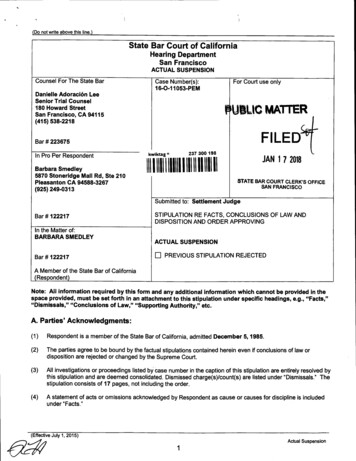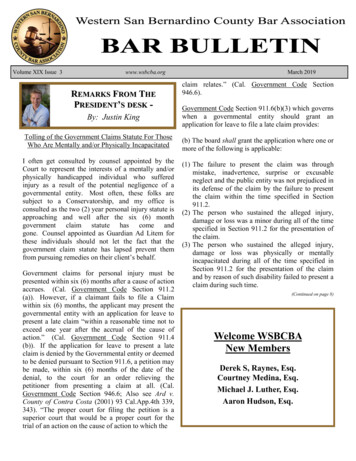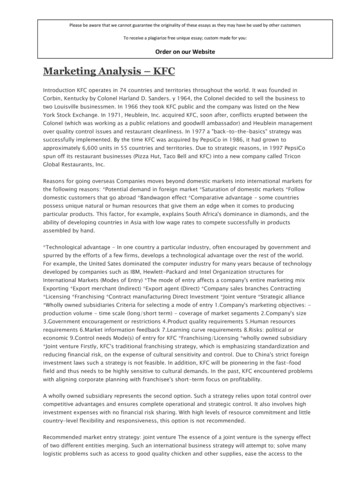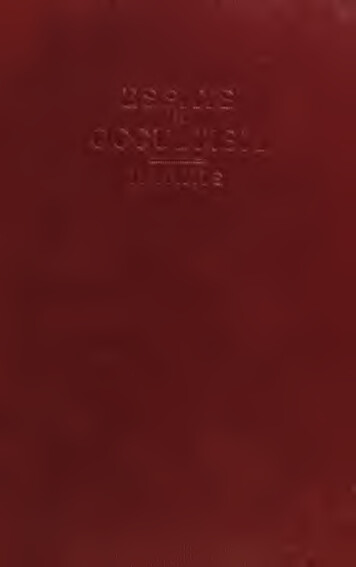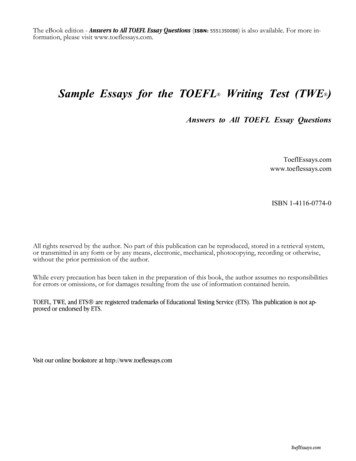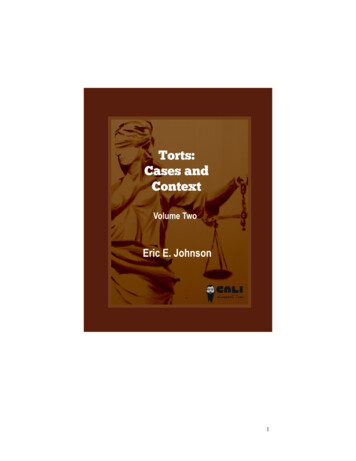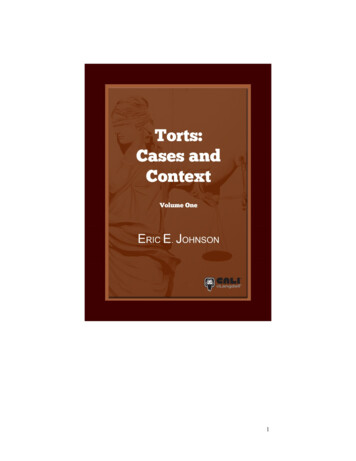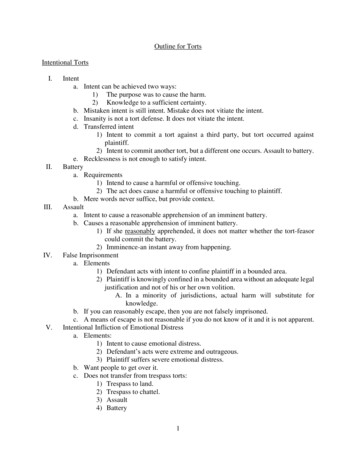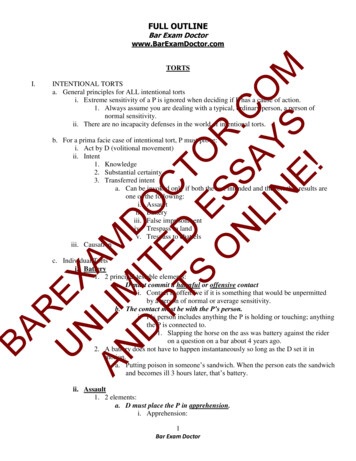
Transcription
FULL OUTLINEBar Exam Doctorwww.BarExamDoctor.comEXN AAN LIM MDD IT OPT ED CTS E OO SS R.NCLI AY ON S ME!TORTSI.INTENTIONAL TORTSa. General principles for ALL intentional tortsi. Extreme sensitivity of a P is ignored when deciding if P has a cause of action.1. Always assume you are dealing with a typical, ordinary person, a person ofnormal sensitivity.ii. There are no incapacity defenses in the world of intentional torts.b. For a prima facie case of intentional tort, P must prove:i. Act by D (volitional movement)ii. Intent1. Knowledge2. Substantial certainty3. Transferred intenta. Can be invoked only if both the tort intended and the tort that results areone of the following:i. Assaultii. Batteryiii. False imprisonmentiv. Trespass to landv. Trespass to chattelsiii. CausationUBARc. Individual Tortsi. Battery1. 2 principal testable elements:a. D must commit a harmful or offensive contacti. Contact is offensive if it is something that would be unpermittedby a person of normal or average sensitivity.b. The contact must be with the P’s person.i. P’s person includes anything the P is holding or touching; anythingthe P is connected to.1. Slapping the horse on the ass was battery against the rideron a question on a bar about 4 years ago.2. A battery does not have to happen instantaneously so long as the D set it inmotion.a. Putting poison in someone’s sandwich. When the person eats the sandwichand becomes ill 3 hours later, that’s battery.ii. Assault1. 2 elements:a. D must place the P in apprehension.i. Apprehension:1Bar Exam Doctor
UBAREXN AAN LIM MDD IT OPT ED CTS E OO SS R.NCLI AY ON S ME!1. Synonym for knowledge here: I apprehend that the capitalof CA is Sacramento.a. David and Goliath question (trick questionwarning): soon to be P is big and strong. Little D isgoing to pick up a stick and waive it at the big guy.One of the choices will say big guy cannot recoverbecause he has not been put in apprehension.i. Apprehension does not mean fear. He hasbeen placed in apprehension because he hasknowledge that he may be struck with astick and that’s all the law requires.2. Unloaded gun problema. D threatens P with a touching, but he is bluffing; hecannot consummate the attack. Put yourself in P’splace in that situation. If P is aware that D lacks theability to complete a battery, then the P knows hecannot be touched and, therefore, no assault.b. On the other hand, if P lacks info one way or theother, that is good enough to give him knowledgethat he could be subject to battery and he will win.i. Doctrine of apparent ability: if it looks likeyou could complete the battery and P thinksyou might be able to, that’s enough.b. Apprehension must be of an immediate battery.i. Immediacy:1. Words alone lack immediacy.a. A verbal threat by itself is not enough to constituteassault on the bar exam.b. You need accompanying physical conduct.2. Even when you have threatening conduct, words maynegate or destroy the immediacy.a. Conditional word or phrase may destroyimmediacy: if you weren’t my best friend, I’d beatthe crap out of you.i. P knows here that he won’t be touched.b. Words that promise action in the future: just youwait until 3 pm and I will haunt you down like thedog that you are (saying this at 9 am).i. This is not a threat of an immediate battery.iii. False imprisonment1. 2 elements:a. D must commit an act of restrainti. Threats are sufficient.1. If you leave this room in the next 30 minutes, I will killyour child.ii. An omission can be an act of restraint.1. This will happen when there is a pre-existing duty on thepart of D to help the P move about.2Bar Exam Doctor
iv. Intentional infliction of emotional distress1. 2 elements:a. D must engage in outrageous conducti. Only a tort to upset someone if you do it through outrageousconduct. It’s apparently ok to upset someone as long as you don’tdo it through outrageous conduct.ii. Conduct is outrageous if it exceeds all bounds of decency toleratedin a civilized society.iii. NOT outrageous: mere insults.iv. Hallmarks of outrageousness (not a complete list):1. The conduct is continuous or repetitive.2. When D is a common carrier or an inn keeper.a. Common carrier transportation company.b. Inn keeper hotel.c. If behave in a way that is marginally outrageous,much more likely to be able to push it over the line.3. If P is a member of a fragile class of persons.a. 3 fragile classes:i. Young childrenii. Elderly peopleiii. Pregnant women (D must know woman ispregnant)v. If you know about someone’s phobia and go ahead with a tastelessjoke anyway, that is outrageous. It is outrageous to go forsomeone’s emotional weak spot.b. P must suffer severe distressi. The severe distress doesn’t have to take any particular form. Norequirement that P suffer observable physical symptoms, see adoctor, miss a prescribed number of days of work, etc.c. Recklessness will satisfy the intent requirement here.d. IIED is the only intentional tort to the person that requires damages.3UBAREXN AAN LIM MDD IT OPT ED CTS E OO SS R.NCLI AY ON S ME!2. Not summoning a wheelchair on a plane for someone whoneeds it.iii. In order for an act of restraint to count, P must either be aware of itor be harmed by it.b. The result must be confinement of the P to a bounded area (plus intentand causation)i. The movement of the P must be constrained in 360 degrees.1. It can be constrained by the scope of a threat.2. The real bar exam trick here is the barricade question: if theD eliminates one route of travel, that is not falseimprisonment because the P, although limited in his abilityto go in that direction, is free to go in other directions.ii. If there is a reasonable means of escape that P can reasonablydiscover, then the area is not a bounded area.1. If the only way out is disgusting, unpleasant, or impossibleto discover, that P is a stuck in a bounded area.iii. P must know of the confinement or be harmed by it.iv. It is irrelevant how short the period of confinement is.Bar Exam Doctor
EXN AAN LIM MDD IT OPT ED CTS E OO SS R.NCLI AY ON S ME!e. Causation in bystander casesi. When D intentionally causes physical harm to a 3rd person and Psuffers severe emotional distress because of it, P may recover byshowing either the prima facie elements of emotional distress orthat:1. She was present when injury occurred;2. She is a close relative of the injured person, and3. D knew facts 1 and 2.vi. Trespass to chattels and conversion1. Both deal with an intentional interference with personal property.2. An act by D that interferes with P’s right of possession in a chattel (plus intent,causation, damages).3. Interference can happen in 2 ways:a. D can damage item in question.b. D can take it away from you.4. The difference between the 2 of them is the degree of interference.5. If interference is modest or slight, appropriate cause of action is trespass tochattels.6. If large interference, appropriate c/a is conversion.7. Damagesa. Conversioni. The P is entitled to recover not merely the cost of damage, butrather the full value of the item in question because theinterference with the chattel is serious.b. Trespass to chattelsi. Cost of repair.UBARv. Trespass to land1. 2 elements:a. Physical invasion by Di. D enters the property.ii. D alternatively can throw or project physical objects onto the land.1. It can be motivated by benign motivations, like wateringneighbor’s flowers. It is still trespass.2. Sight, sound, smell -- not physical invasions. Maybe aclaim for nuisance, but not a trespass claim.b. Land (plus intent and causation)i. The land in P’s control includes the air above and the soil belowout to a reasonable or usable distance.ii. A kid throwing a ball over your backyard, even if not falling onyour land or touching anything, constitutes a trespass.d. Affirmative defenses to intentional tortsi. Consent1. P must have legal capacity because only a person with legal capacity can giveconsent.a. A drunk cannot consent to being hit.b. Children can consent to age appropriate stuff, but they cannot consent tothings that normally would require adult judgment.4Bar Exam Doctor
ii. Protective Privileges: Self defense, defense of others, and defense of property1. D must demonstrate 2 things:a. Proper timingi. When the invasion in question is imminent or in progress. Alreadycommitted torts do not qualify.b. Reasonable belief that the invasion was genuinei. A reasonable mistake will not negate the protective privileges.ii. Ex: shopkeeper’s privilege.2. You are obligated to use only the amount of force necessary to protect theprivileges. The amount of force must be responsive and symmetrical to the attack.3. You may NEVER use deadly force to protect property, no matter how valuablethe property may be.a. No deadly traps to protect your property.4. Self-defenseUBAREXN AAN LIM MDD IT OPT ED CTS E OO SS R.NCLI AY ON S ME!2. Methods of consentinga. Express consenti. Words spoken or written that give D permission to behave in whatwould otherwise be a tortious manner.ii. Exceptions:1. Express consent is disregarded if there was fraud or duressinvolved (unless duress is only threats of future action orfuture economic deprivation).a. Ex: one night stand where one person has an STDand does not tell the other person about it. Personwho gets infected can now sue for battery becausewithdrawing that info denies consent.2. Mistake will undo express consent if D knew of and tookadvantage of the mistake.b. Implied consenti. Two ways:1. Custom and usagea. Ex: playing sports.b. In a sports case, the implied consent goes toeverything that is customary or routine to the gamewhether it conforms to the rules of the game orviolates them. We are just interested in whatcustomarily happens.2. Based on D’s reasonable interpretation of P’s objectiveconducta. P’s subjective thoughts are not part of the legalanalysis.3. Consent implied by law arises when action is necessary tosave a person’s life or some other important interest inperson or property.3. Scopea. If D exceeds scope of consent, D goes right back to being liable for a tort.b. Ex: medical procedures.5Bar Exam Doctor
EXN AAN LIM MDD IT OPT ED CTS E OO SS R.NCLI AY ON S ME!a. When a person reasonably believes that she is being or is about to beattacked, she may use such force as is reasonably necessary protect againstinjury.b. A reasonable mistake as to the existence of the danger is allowed.5. Defense of othersa. One may use force to defend another when the actor reasonably believesthat the other person could have used force to defend himself.b. Reasonable mistake permitted.6. Defense of propertya. A request to desist or leave must first be made unless it would be futile ordangerous.b. Reasonable mistake allowed as to whether an intrusion occurred orwhether a request to desist is required, but not as to whether the entranthas a privilege (e.g., necessity) that supersedes the defense of propertyright.iv. Necessity1. Only going to arise in the 3 property torts: trespass to land, chattels, conversion.2. A person may interfere with the real or personal property of another when it isreasonably and apparently necessary to avoid threatened injury from a natural orother force and when the threatened injury is substantially more serious than theinvasion that is undertaken to avert it.3. Two types:a. Public necessityi. Arises when D invades P’s property in an emergency to protect thecommunity as a whole or a significant group of people.ii. P recovers nothing. It’s an absolute defense.b. Private necessityi. When D invades P’s property in an emergency to protect aninterest of his own.ii. Limited defense. 3 legal consequences to private necessity:1. D must pay for actual harm done.2. D never liable for nominal or punitive damages.3. As long as the emergency continues, D may remain on P’sproperty in a position of safety. He cannot be expelled orejected so long as the emergency persists: right ofsanctuary.UBARiii. Privilege of arrest1. Depending on the facts, the actor may have a privilege to enter another’s land forthe purpose of effecting the arrest.2. It carries with it the privilege to enter another’s land for the purpose of effectingthe arrest.3. The actor may still be liable for subsequent misconduct.4. If arrest for misdemeanor, privileged only if for a breach of peace and action takesplace in front of D.5. For felony arrests, a police officer may make a reasonable mistake. Citizens maymake a reasonable mistake regarding the identity of the felon, but not regardingwhether the felony occurred.6Bar Exam Doctor
DEFAMATIONa. 3 elements:i. D must make a defamatory statement specifically identifying the P;1. A statement is defamatory if it tends to adversely affect your reputation.2. The cts are consistent in holding that mere name calling is NOT defamatory.3. Look for an allegation of fact that reflects negatively on a trait of character.a. Honestyb. Loyaltyc. Couraged. Competencee. Sexual morality4. P must be alive at the time the statement was made.5. If the statement does not refer to P on its face, extrinsic evidence may be offeredto establish that the statement refers to P. this is known as pleading colloquium.ii. D must publish the statement;1. The defamatory statement must be shared with at least 1 person other than the Phimself.2. Negligent publication will suffice.3. It is the intent to publish, not the intent to defame, that is the requisite intent.4. Each repetition is a separate publication.a. But for magazines, newspapers, etc., most states have adopted a singlepublication rule under which all copies are treated as one publication.iii. Damages, maybe.1. Libel cases – defamation written down or embodied in a permanent formata. A libel P need not prove damages to get to the jury.2. Slander per se – slander that falls within 4 specific itemized areas that the law hasconsidered to be devastating to reputation. It gets the same rule as libel withregard to damages. In slander per se, damages are also presumed.a. State
FULL OUTLINE Bar Exam Doctor . www.BarExamDoctor.com . TORTS. I. INTENTIONAL TORTS a. General principles for ALL intentional torts . i. Extreme sensitivity of a P is ignored when deciding if P has a cause of action. 1. Always assume you are dealing with a typical, ordinary person, a person of normal sensitivity. ii. There are no incapacity defenses in the world of intentional torts.File Size: 1MBPage Count: 37

